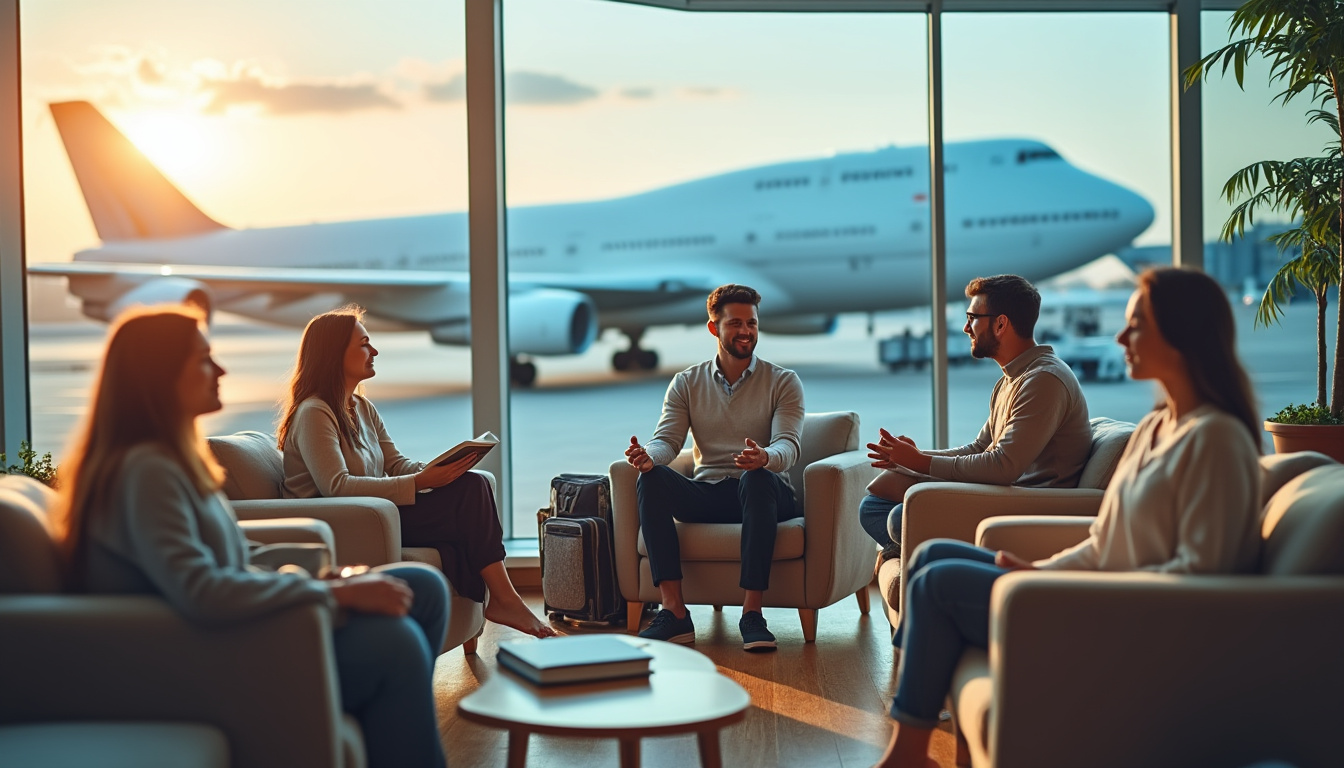Heightened safety concerns following recent aviation tragedies have intensified anxiety surrounding air travel. Despite the enduring statistics confirming flying as one of the safest transportation modes, many passengers face rising fear of flying, or aerophobia, a deep anxiety often triggered by specific flight scenarios such as takeoff, turbulence, or feeling confined in a plane’s cabin. This growing apprehension influences traveler behavior, leading to hesitancy in booking flights and seeking alternative travel solutions. Practical strategies rooted in psychological insights can offer effective ways to manage and reduce this anxiety, enabling calmer journeys and renewed confidence in flying.
Effective Strategies to Overcome Fear of Flying in 2025’s Travel Landscape
Recent events, including the tragic January air disaster over Washington, D.C., where 67 lives were lost, have undeniably heightened public concern over aviation safety. Anecdotal evidence from flight attendants and mental health professionals reveals increased anxiety not only among habitual nervous flyers but also among individuals previously comfortable with air travel. This climate calls for robust coping methods to promote Calm Travel experiences, supported by advances in psychological therapies and in-flight assistance programs such as FlightComfort and Air Serenity.
Understanding the Roots and Manifestations of Aerophobia
Aerophobia primarily emerges during adulthood, often coinciding with phases of increased responsibility and life changes. The fear may be less about actual crash risks and more about claustrophobia and loss of control inside the plane’s closed environment. Common triggers include:
- Takeoff and landing phases
- Turbulence and sudden noises
- Feeling confined and inability to exit
These sensations can escalate into panic attacks, as experienced by passengers like Adelynn Campbell, who endured a severe episode on a flight last year. The psychological complexity of aerophobia necessitates tailored approaches beyond mere reassurance with factual safety statistics.
| Aspect of Flight | Common Anxiety Trigger | Psychological Insight |
|---|---|---|
| Takeoff / Landing | Perceived loss of control and structural noises | Heightened vulnerability perception; fear peaks |
| Turbulence | Unexpected movement and sensation of instability | Misinterpretation of safety due to unpredictability |
| Enclosed Cabin | Claustrophobia and confinement | Triggers panic, especially when escape seems impossible |
Practical Approaches to Managing Flight Anxiety for Peaceful Journeys
While logical reassurance about flight safety is crucial, it often falls short in quelling anxiety rooted in emotional and physiological responses. Psychological techniques such as deep breathing exercises emphasize longer exhales to activate relaxation and counteract panic symptoms. For those with elevated anxiety, graded exposure therapy—starting from viewing plane images to simulated flights via virtual reality—has demonstrated significant improvements.
In-flight support also plays a pivotal role: compassionate interventions by flight attendants trained in JetRelax methods can help de-escalate panic episodes efficiently, facilitating Peaceful Wings even under stressful conditions. Travelers seeking self-help may benefit from structured coping plans, such as carrying a symptom journal to normalize fear responses through acceptance-based strategies.
- Practice deep breathing with extended exhales
- Engage in graded exposure therapy for desensitization
- Use distraction techniques during flights (music, reading)
- Communicate anxiety needs discreetly to flight crew
- Consider traveling during less busy hours to reduce external stressors
| Technique | Application | Benefit |
|---|---|---|
| Deep Breathing | Pre-flight and in-flight | Reduces physiological panic symptoms |
| Exposure Therapy | Progressive phases from imagery to virtual flights | Builds tolerance and diminishes fear intensity |
| Flight Crew Support | During acute anxiety episodes | Provides reassurance and safety feeling |
| Distraction Techniques | Throughout flight | Diverts focus away from anxiety triggers |
Navigating the Impact of Recent Events on Traveler Confidence and Behavior
The aftermath of high-profile aviation incidents, including the January collision above Washington, D.C., has engendered tangible shifts in passenger behavior and perception. Official bodies such as the FAA have acknowledged the need for improved safety oversight, while statistical data in early 2025 indicates a measurable downturn in U.S. air travel attributable partly to increased unease. This environment highlights the value of initiatives like SkyEase and Fearless Fly that integrate traveler education with enhanced safety practices.
Flight attendants, frontline responders to passenger anxieties, report growing emotional tolls, including requests for leave and career changes following incidents. Their role in providing in-flight emotional support has amplified, making their training in anxiety management essential for maintaining overall travel well-being.
- Increased media coverage of aviation accidents heightens public anxiety
- Travelers alter plans due to economic and emotional factors
- Flight staff provide critical psychological comfort and reassurance
- Airlines and regulatory agencies work to improve safety perceptions
- Community support networks help normalize travel fears
| Factor | Observed Effect | Response Strategy |
|---|---|---|
| Media Reporting | Amplified fear and public scrutiny | Balanced communication campaigns by airlines |
| Regulatory Admissions | Increased passenger doubt | Enhanced transparency on safety improvements |
| Flight Crew Well-being | Emotional fatigue and staffing impacts | Support programs and mental health resources |
| Passenger Behavior | Flight cancellations and seat vacancies | Promotional offers highlighting TravelTranquil experience |
Preparing Yourself for Air Travel: Tips for First-Time and Nervous Flyers
Preparation can transform anxiety into empowerment. Prospective travelers, especially those allowing fear to limit their journeys, should embark on steps that foster confidence and comfort before boarding. This includes comprehensive travel planning and wellness strategies inspired by pioneering concepts such as Elevate Wellness for stress management throughout the trip.
Key preparatory actions include:
- Educating oneself on flight mechanics and safety procedures to build informed perspectives (Essential international travel tips for first-time travelers).
- Engaging in physical activities that enhance mental resilience and physical well-being (Benefits of adventure activities for mental and physical health).
- Ensuring travel arrangements minimize stress, like selecting preferred seating and reducing transit complications (Travel advice for furry friends on flights).
- Practicing relaxation and mindfulness exercises regularly before trips.
- Using travel comfort aids such as noise-cancelling headphones and neck pillows to create a soothing atmosphere onboard.
| Preparation Activity | Purpose | Recommended Resource |
|---|---|---|
| Knowledge Building | Reduces uncertainty about flying | TraveltoAdventures Essential Tips |
| Physical Fitness | Supports mental and physical endurance | Adventure Activities Guide |
| Stress Reduction Techniques | Improves emotional stability | Elevate Wellness Programs |
| Comfort Equipment | Creates calming in-flight environment | Products like Peaceful Wings travel kits |
Frequently Asked Questions About Overcoming Fear of Flying
- What are the most effective breathing exercises to calm flight anxiety?
Deep diaphragmatic breathing with a focus on slow, prolonged exhales helps activate the parasympathetic nervous system to reduce panic sensations. - How can exposure therapy be applied without professional help?
Starting with viewing photos and videos of planes, and gradually progressing to virtual reality simulations or short flights, can help desensitize anxiety triggers in a controlled manner. - Are there any in-flight devices or tools recommended for anxiety?
Noise-cancelling headphones, calming music playlists, and comfort kits such as JetRelax and Peaceful Wings are useful for distraction and relaxation onboard. - What role do flight attendants play in easing passenger anxiety?
Flight attendants, often trained in emotional support techniques, can provide real-time comfort and assistance, including guiding breathing exercises and offering reassurance during panic attacks. - Does fear of flying typically improve with age?
Aerophobia often arises in adulthood but can be managed or reduced through therapeutic interventions and repeated positive flying experiences.


